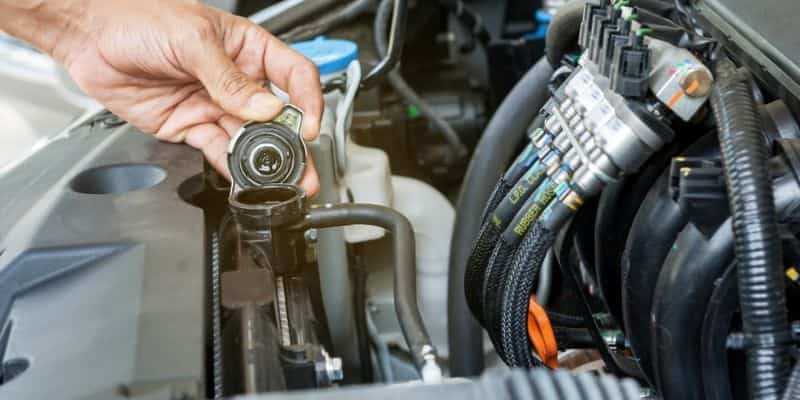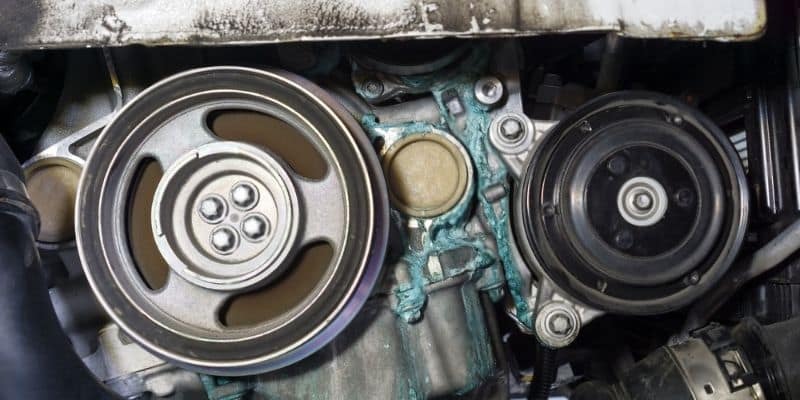Coolant leaks in a car can be a cause for concern as they can lead to engine overheating and potential damage. In this comprehensive guide, we will explore the topic of coolant leaks when car is running, discussing their causes, signs, potential consequences, and appropriate actions to take.
Understanding Coolant Leaks
Coolant, also known as antifreeze, plays a crucial role in maintaining your car’s optimal temperature. It circulates through the engine, absorbing heat and preventing it from overheating. A coolant leak occurs when this fluid escapes from the cooling system.
Causes of Coolant Leak When Car is Running
Coolant leaks in a car can occur due to various reasons. Let’s explore the common causes:
1. Damaged Radiator
The radiator is an essential component of the car’s cooling system. It is responsible for cooling the hot coolant that flows through it.
Over time, the radiator can develop cracks or corrosion due to age, exposure to harsh conditions, or the use of low-quality coolant.
When the car is running, the increased pressure and circulation of coolant can exacerbate these issues, causing coolant to leak from the radiator.
2. Faulty Radiator Cap
The radiator cap is designed to maintain the appropriate pressure within the cooling system. If the cap is loose, damaged, or doesn’t seal properly, it can allow coolant to escape.
The higher pressure generated by the circulating coolant can push the coolant past the faulty cap, resulting in leaks.
3. Damaged Hoses
The cooling system relies on hoses to transport coolant between the radiator, engine, and other components. Over time, these hoses can become worn, cracked, or loose at the connections.
The increased pressure and heat in the cooling system can cause the damaged hoses to further deteriorate, leading to coolant leaks.
4. Water Pump Issues
The water pump is responsible for circulating coolant throughout the engine, ensuring proper cooling. If the pump’s seals wear out or the bearings fail, it can result in coolant leaks.
The water pump operates at higher speeds, increasing the pressure on the seals. This can cause them to fail, leading to coolant leakage.
5. Leaking Heater Core
The heater core, located inside the car’s cabin, is responsible for providing warm air for heating. If the heater core develops leaks, coolant can escape into the vehicle’s interior.
When the car is running, the circulation of coolant through the heater core intensifies, increasing the likelihood of coolant leaking into the cabin.
6. Engine Gasket Failure
Faulty gaskets, such as the head gasket or intake manifold gasket, can cause coolant leaks. When these gaskets fail, coolant can seep into the engine cylinders or mix with oil, resulting in further engine damage.
The internal pressure and temperature of the engine can worsen the gasket failure, leading to coolant leaks.
7. Cracked Engine Block
In rare cases, a cracked engine block can cause coolant leaks. This can occur due to engine overheating, freezing temperatures, or manufacturing defects.
The pressure and circulation of coolant can force it through the cracks in the engine block, resulting in coolant leakage.
Signs of Coolant Leak When Car is Running
Here are the signs of coolant leaks when a car is running:
1. Low Coolant Level
If you notice a significant decrease in the coolant level on the coolant reservoir or radiator when the car is running, it is a clear indication of a coolant leak.
When the car is running, the circulating coolant can escape through cracks, damaged hoses, or faulty components, causing the coolant level to drop.
2. Overheating Engine
Coolant plays a vital role in regulating the engine’s temperature. If there is a coolant leak while the car is running, it can result in insufficient coolant reaching the engine.
This can lead to overheating, as the coolant’s cooling properties are compromised.
If you notice the temperature gauge rising above the normal range or steam coming from the engine bay while the car is running, it is a strong indication of a coolant leak.
3. Sweet Smell or Steam
When coolant leaks and comes into contact with hot engine surfaces, it can produce a distinct sweet smell. If you perceive a sweet aroma while driving, especially when the car is running, it may indicate a coolant leak.
Additionally, if you notice steam rising from the engine bay or a white vapor coming out of the exhaust while the car is running, it suggests that coolant is being burned or escaping through a leak.
4. Coolant Puddles or Stains
After parking a running car, inspect the ground beneath it for coolant puddles or stains. Coolant leaks often leave behind visible traces on the ground or surfaces near the radiator, hoses, or engine components.
These puddles or stains may appear green, yellow, or pinkish, depending on the type of coolant used. Finding such evidence after the car has been running indicates an active coolant leak.
5. Engine Misfires or Poor Performance
Coolant leaks that occur near the engine cylinders, such as through a faulty head gasket, can result in coolant entering the combustion chamber.
This can lead to engine misfires, a rough-running engine, or a noticeable decrease in performance.
If you experience these issues while the car is running, it may suggest a coolant leak affecting the engine’s combustion process.
6. Interior Heater Malfunctions
If the car’s heating system is not functioning correctly while the car is running, it could be due to a leaking heater core.
Coolant leaks in the heater core may cause inadequate heat output, a damp or sticky feeling inside the cabin, or even fogging of the windshield.
These symptoms indicate a coolant leak affecting the heater core when the car is in operation.
By understanding these signs, drivers can promptly identify coolant leaks while the car is running and take appropriate measures to address them, preventing further damage to the cooling system and engine.

Consequences of Ignoring Coolant Leak When Engine is Running
Here are the possible outcomes of neglecting a coolant leak:
Engine Overheating: Coolant plays a critical role in regulating the engine’s temperature. When a coolant leak is ignored, the coolant level decreases, resulting in insufficient coolant reaching the engine.
This can lead to engine overheating, which can cause severe damage to engine components such as the cylinder head, piston rings, and valves. Overheating can also warp the engine block or cylinder head, leading to costly repairs or even engine failure.
Increased Risk of Engine Damage: Coolant not only helps regulate temperature but also provides lubrication to various engine components.
When a coolant leak is left unaddressed, the lack of proper lubrication can cause increased friction and wear on vital engine parts.
This can result in premature engine failure, reduced engine performance, and costly repairs or engine replacement.
Risk of Engine Seizure: Continued driving with a coolant leak can eventually lead to the engine seizing. As coolant levels drop and engine temperatures rise, the metal surfaces within the engine can expand and warp.
This can cause pistons to seize inside the cylinders, resulting in a complete engine failure. An engine seizure often necessitates a complete engine rebuild or replacement, which is a significant expense.
Damage to Cooling System Components: Coolant leaks can impact other cooling system components such as the radiator, hoses, water pump, and thermostat.
When coolant levels are low due to a leak, these components may not receive sufficient coolant for proper functioning.
This can lead to overheating, reduced cooling efficiency, and potential damage to these critical components. Repairing or replacing these parts can be costly.
Reduced Fuel Efficiency: Engine overheating caused by a coolant leak can result in reduced fuel efficiency. An overheated engine requires more energy to function, leading to increased fuel consumption.
Ignoring the coolant leak can result in ongoing poor fuel efficiency and increased fuel costs.
Safety Risks: Coolant leaks can pose safety risks. Coolant dripping onto the road can create a slippery surface, increasing the chances of accidents, particularly in wet conditions.
Additionally, if the coolant leak affects the heater core, it can impair the defrosting function, reducing visibility and compromising driver safety.
Ignoring a coolant leak while the engine is running can lead to severe consequences, including engine damage, overheating, reduced fuel efficiency, costly repairs, and safety risks.
What to Do When You Notice a Coolant Leak During Driving?
Here’s what you should do when you observe a coolant leak:
Safely Pull Over: As soon as you notice a coolant leak, find a safe place to pull over. This will prevent the engine from overheating and minimize the risk of further damage.
Turn Off the Engine: Once you have safely pulled over, turn off the engine to prevent any additional coolant loss and reduce the risk of overheating.
Allow the Engine to Cool: It’s crucial to give the engine sufficient time to cool down before attempting to inspect or address the coolant leak. This will help prevent burns or injuries from hot engine components.
Inspect the Source of the Leak: Once the engine has cooled, visually inspect the engine bay and underside of the car to locate the source of the coolant leak.
Look for signs of coolant puddles, stains, or wet areas around the radiator, hoses, water pump, and other cooling system components.
Check Coolant Level: Carefully check the coolant level in the reservoir or radiator. If the coolant level is significantly low, do not attempt to drive the car without addressing the leak.
Continuing to drive with low coolant levels can result in engine overheating and damage.
Refill Coolant (If Necessary): If you have access to coolant and the coolant level is low, you can add coolant temporarily to prevent further overheating.
However, keep in mind that this is a temporary solution, and you should still address the underlying coolant leak as soon as possible.
Seek Professional Assistance: It’s recommended to contact a professional mechanic or tow the vehicle to a trusted auto repair shop to diagnose and repair the coolant leak.
They have the expertise and tools to properly assess the issue and perform the necessary repairs or replacements.
Avoid Driving (If Possible): If the coolant leak is severe or you are unable to add coolant, it’s best to avoid driving the car until the issue is resolved. Driving with a coolant leak can lead to engine overheating and further damage.
Frequently Asked Questions (FAQs)
Q1: What causes a coolant leak in a car?
A coolant leak in a car can be caused by various factors, including damaged or worn-out hoses, a faulty radiator, a cracked or damaged coolant reservoir, a malfunctioning water pump, a blown head gasket, or a corroded heater core.
Q2: How can I tell if my car has a coolant leak?
Some common signs of a coolant leak include low coolant levels, engine overheating, a sweet smell inside or outside the car, steam or vapor coming from the engine bay or exhaust, coolant puddles or stains on the ground, and poor heater performance.
Q3: Can I drive my car with a coolant leak?
It is generally not recommended to drive a car with a coolant leak, as it can lead to engine overheating and severe damage.
If you notice a coolant leak, it’s best to address it promptly and avoid driving the vehicle until the issue is resolved.
Q4: Can I fix a coolant leak myself?
Depending on the severity and location of the coolant leak, you may be able to fix it yourself. Small leaks in hoses or connections can sometimes be repaired with special sealants or by tightening clamps.
However, for larger or more complex leaks, it is advisable to seek professional help from a qualified mechanic.
Q5: How much does it cost to repair a coolant leak?
The cost of repairing a coolant leak can vary depending on the nature of the leak, the affected components, and the make and model of the car.
Simple repairs like replacing a hose or fixing a loose connection may cost less, while more extensive repairs like replacing a radiator or water pump can be more expensive.
Q6: How can I prevent coolant leaks in my car?
To prevent coolant leaks, you should regularly inspect the cooling system, maintain proper coolant levels, use the recommended coolant, replace coolant at the recommended intervals, and address any signs of wear or damage to hoses and other components.
Conclusion
Coolant leaks when a car is running should never be ignored. Identifying the causes, recognizing the signs, and taking appropriate action are crucial to prevent engine damage and ensure the safety and longevity of your vehicle.

Hi, Michael Williams here. I have always loved everything with an engine. After earning my degree in automotive engineering, I spent 5 years testing vehicles for a major manufacturer in Illinois. Now I am using my technical skills to review the latest models online and help others troubleshoot their engine problems with effective solutions.
